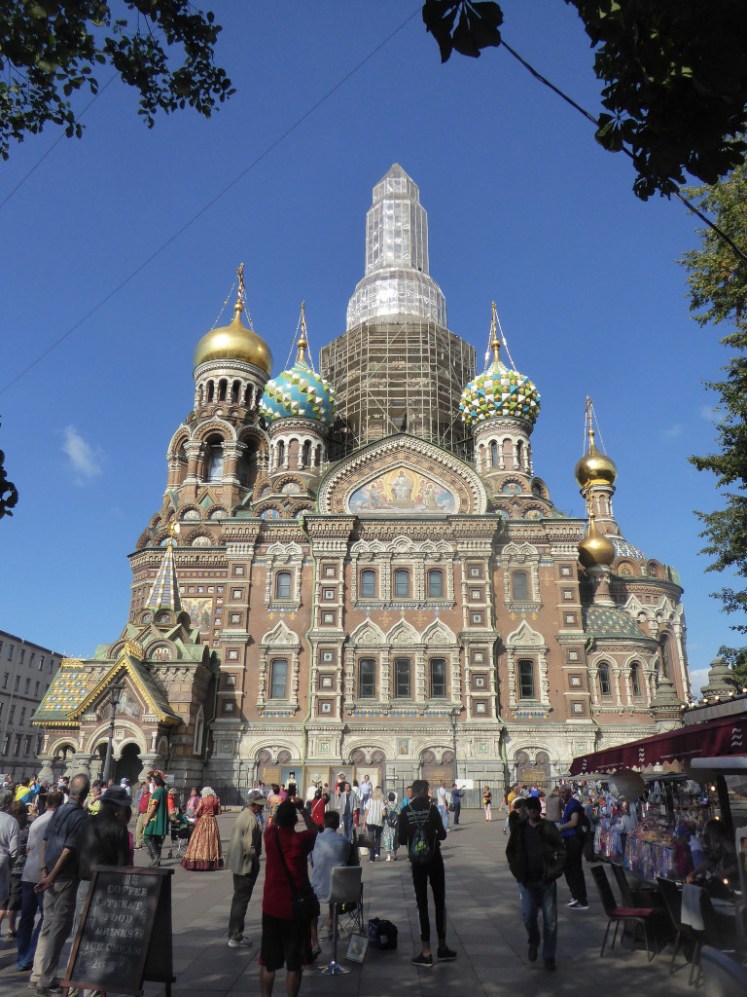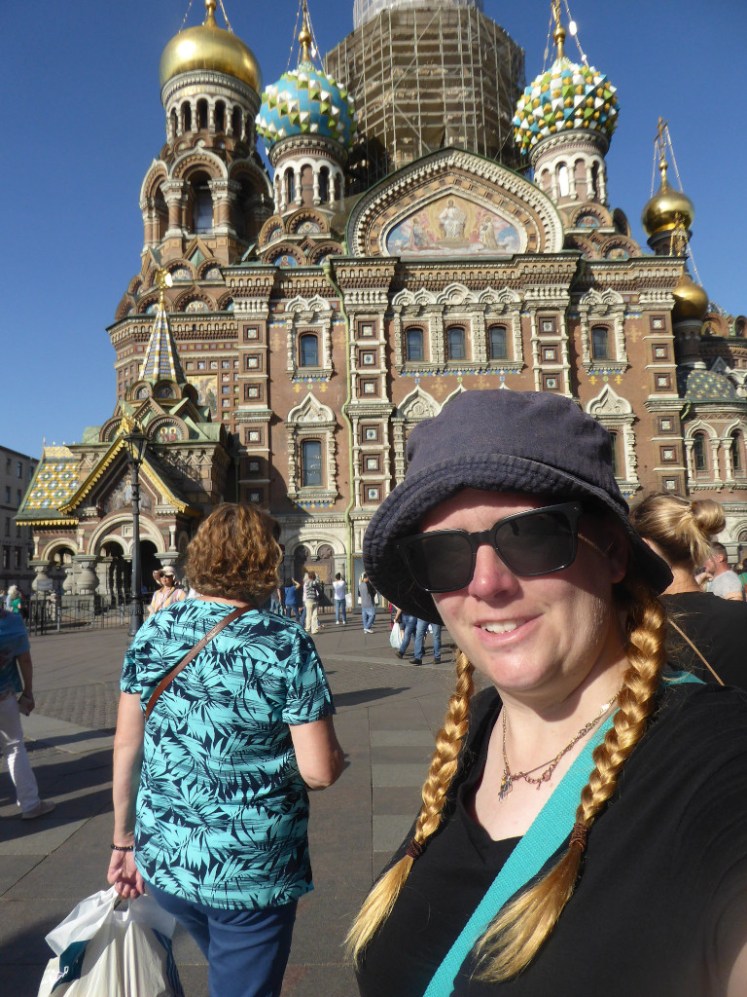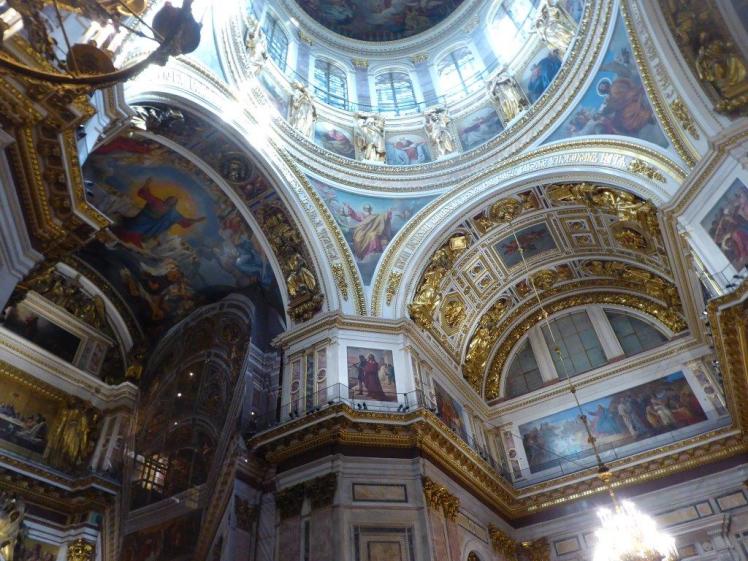There are two main churches to visit in St Petersburg, once you’re done with all the other delights like the Peter & Paul Fortress, the Hermitage labyrinth and more palaces than you can imagine, many of them now home to the sort of staples a big city like this needs more in the twenty-first century than palaces, like shops, restaurant and housing.
The first and most obvious church is the Church of the Saviour on Spilled Blood, which anyone on our 2002 trip will forever call “the Speelblod” because that’s how our tour guide pronounced it, much to everyone’s bewilderment.

It was built between 1883 and 1907 on the site of the 1881 assassination (on spilled blood) of Tsar Alexander II. Having survived a carriage bomb and rolled, shell-shocked, onto the cobbled street, he was immediately taken out by a second bomb that was thrown straight at his feet. A third bomber was lurking in case the first two both failed. And because he was a Tsar, he didn’t merely have a tomb, he had an entire church built for him. It was started in the days of his son Alexander III but not finished until the reign of his grandson, Nikolai II, which is a name you’ve probably heard a couple of times already if you’re following this story chronologically, in conjunction with the word “Ekaterinburg” which is when I’m going to tell his story properly.

The Church on Spilled Blood isn’t quite as spectacular as Moscow’s St Basil’s but it’s a pretty good second. I daresay there are other amazing churches in Russia but as most tourists are only going to see the ones in these two cities, we’ll call it the second best church in Tourist Russia (And I didn’t see anything in their league at all in Murmansk, Ekaterinburg or Perm).

For all the colour and glory on the outside, it’s more conventional inside than St Basil’s. That is, it’s a large hollow church instead of nine small churches pressed up against each other. It’s not conventional by British standards. There isn’t a single inch of bare stone in this entire building. It’s painted and mosaiced and gilded from floor to ceiling. Colourful is great but in a building that wasn’t designed with 21st century lighting it makes it a little bit dark. The windows are narrow and high and although it’s reasonably light all things considered, it’s not the light and airy thing that somewhere like the grey-and-white Winchester cathedral is.The trouble is that this is one of St Petersburg’s top three tourist attractions and it’s the busiest place I saw in the entire country. It’s tour group after tour group and they’re all huge. It’s chaos. You can hardly move. Maybe you should come early in the day. Maybe come outside high season. I was there September 1st, I think, a hot summer Sunday.


It was closed during Russia’s Soviet era. The Soviets didn’t like religion very much. If you remember, they demolished Moscow’s Cathedral of Christ the Saviour. The Spilled Blood got off a little lighter. It became a temporary morgue for the dead of the Siege of Leningrad and after the war became the most elaborate storehouse in the world, apparently nicknamed the Church on Spilled Potatoes. It wasn’t until the 1970s it was reopened as a church, although as a museum rather than a consecrated church.
The other important church in St Petersburg is St Isaac’s Cathedral, which isn’t quite as striking-looking, although the big golden dome is quite the landmark. It’s a nice cathedral: stately, neoclassical, but it doesn’t have the colours or the onion domes or the attention-grabbingness of the Spilled Blood so it doesn’t tend to make the “must-do in St Petersburg” lists.

The interior is also much-decorated but in a more muted way, with stoney-creamy colours dominating the walls and the really decorative gold and paintings and murals not beginning until near the ceiling or even on it. One key feature is the set of bright green malachite columns. Russia likes malachite but I hadn’t noticed that at this point – that will come when I go to the Hermitage in my next post.

But you don’t go to St Isaac’s for the interior, not really. You go there for the views from the roof. It’s a lot of spiral steps but at least they use a different corner for up and down so you’re never caught trying not to fall to your death from the narrow end of the steps when someone comes in the other direction and you have to get out of their way like in the spire of St Olaf’s in Tallinn (not that those steps mentally scarred me for life…). St Isaac’s does trick you into thinking you’re at the top twice when you’re not at all and the final ascent is something I think of as a gangplank and then you’re finally at the top.

It doesn’t have the wide purpose-built viewing platforms of Moscow’s Cathedral of Christ the Saviour. It just has a fairly narrow walkway encircling the colonnades below the dome and although I don’t think there are any signs, most people automatically go in the same direction. There just isn’t space to decide to rebel against the flow of traffic. Getting the space for a really quick selfie with the city is hard enough – the people who are attempting to turn it into an art form are really clogging up the passing places and hogging the views. And anyway, it’s a bit shaded under the colonnades and the city was very brightly sunlit so all the selfies come out sillhouetted anyway.

You don’t realise how many churches there are in St Petersburg until you’re seeing it all from above. Oddly, the Church on Spilled Blood doesn’t stand out as much as you think it would. That may be because its central tower was covered in scaffolding when I was there or it may be because it’s more brown than you realise or it may be simply because it’s further away than I thought it was. The Peter & Paul Fortress and Cathedral are more obvious, thanks to their positioning on the edge of the river where there’s nothing crowding it out. Also, the cathedral is bright yellow and has a really high gold spike on top.

The Arsenal, another bright yellow building, is pretty easy to spot because of another yellow and gold tower which sticks out above the trees that obscure most of the building. And then the Winter Palace, St Petersburg’s jewel, is an enormous slab of mint-and-white palace that looks like someone landed it in the middle of the city. Standing in front of it in Palace Square, it doesn’t look so big. Well, it does look big but when seen from above, it looks absolutely enormous. Finally, in the distance, you can see the 462m-high Lakhta Tower, the tallest building in Russia, just completed this year. A glass spike, standing alone, is very obvious above the cityscape and it doesn’t quite fit in with the baroque and neoclassical architecture that makes up the rest of St Petersburg.

Next time: as I hinted above, I’m going into the Hermitage. They say it would take a year to glance at every exhibit in the entire museum: will I make it out before closing time?